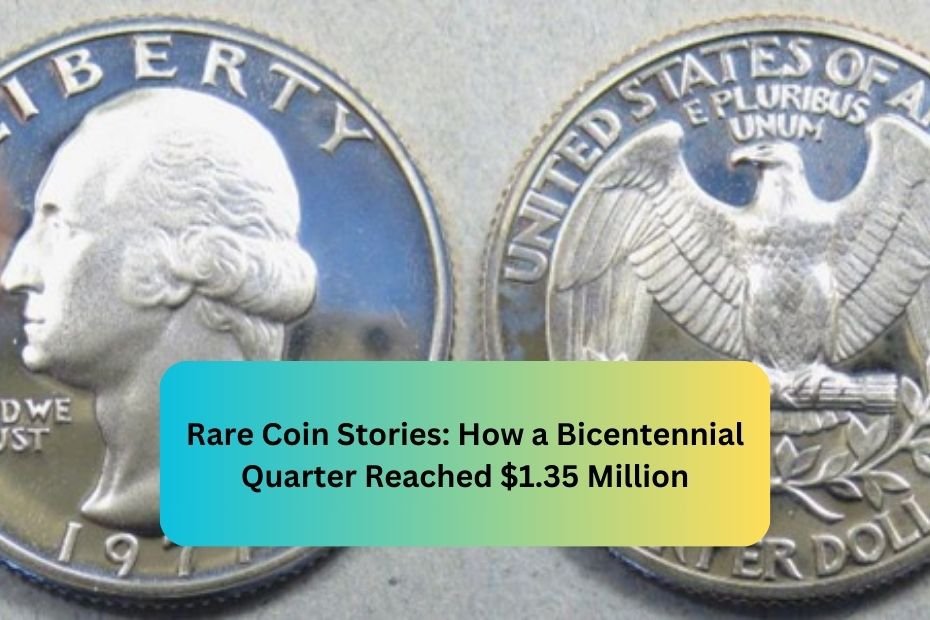Coins tell stories that span centuries, reflecting history, culture, and national milestones. Rare coins, especially those with unique characteristics or historical significance, often become the subject of fascination and can fetch staggering prices at auctions. One of the most surprising success stories in the numismatic world is that of the Bicentennial quarter, which was minted to commemorate America’s 200th anniversary of independence in 1976. What makes this particular quarter unique is how one version of the coin reached an astonishing auction price of $1.35 million.
This story takes us through the quarter’s history, its special design features, the factors contributing to its extraordinary value, and why collectors were so captivated by this rare coin.
The Bicentennial Quarter: A Commemorative Coin
A Historic Moment
In 1976, the United States celebrated its 200th anniversary of independence. To mark this special occasion, the U.S. Mint released commemorative coins, including quarters, half dollars, and dollars. These coins featured unique designs representing American history and values.
The Bicentennial quarter, in particular, captured the public’s attention. Unlike standard quarters, which bore the familiar eagle on the reverse, the Bicentennial quarter featured a special design by Jack L. Ahr. His design depicted a Colonial drummer in front of a torch encircled by 13 stars, symbolizing the original colonies. The obverse still carried the image of George Washington, but instead of the typical date, it bore the dual years “1776-1976.”
A Wide Circulation
The U.S. Mint produced millions of Bicentennial quarters, meaning that most of these coins are relatively common and hold little more than face value today. However, some rare varieties, including errors, low-mintage proofs, and coins made of precious metals, have become valuable collector’s items.
The Coin That Stood Out
The Origins of the Rare Bicentennial Quarter
What sets the $1.35 million Bicentennial quarter apart from its more common counterparts is its composition and striking. While the bulk of these quarters were made from a standard copper-nickel alloy, a limited number of them were struck in 40% silver. These silver quarters were primarily included in special coin sets sold to collectors.
In 1975, the San Francisco Mint struck several silver proof Bicentennial quarters. These proof coins were meticulously struck with polished dies, resulting in sharp details and a brilliant finish. However, one particular coin stood out among these silver proof quarters — it was double-struck, creating a dramatic error that would later make it one of the most valuable quarters in history.
Double-Struck Error
Coin errors are mistakes that occur during the minting process, and they often pique the interest of collectors due to their rarity. The $1.35 million Bicentennial quarter was double-struck, meaning the coin was struck twice by the die during production. This error resulted in a distinctive, overlapping image that is clearly visible on both sides of the coin.
This kind of error is incredibly rare, especially on a proof coin, which is typically subject to more rigorous quality control. The double strike not only made this coin a unique specimen, but it also turned it into a highly desirable collectible.
The Journey to $1.35 Million
Condition and Rarity
The condition of a coin plays a significant role in determining its value. The $1.35 million Bicentennial quarter was graded at an exceptionally high level, achieving a Proof 70 (PR70) rating from the Professional Coin Grading Service (PCGS), which is the highest grade a coin can receive. This means that the coin was in perfect condition with no visible flaws under magnification.
When you combine the coin’s pristine condition with the rarity of its double-strike error, it becomes clear why collectors were willing to bid high for this exceptional piece of American numismatic history.
The Auction That Made Headlines
In 2022, this particular Bicentennial quarter went up for auction at a major numismatic event. The excitement surrounding this coin was palpable. Rare coin collectors from around the world were eager to get their hands on this one-of-a-kind piece.
As the auction unfolded, bids climbed higher and higher, eventually reaching a jaw-dropping final price of $1.35 million. This set a new record for the highest price ever paid for a U.S. quarter, cementing the coin’s place in numismatic history.
Why Collectors Were So Enthralled
Historical Significance
The Bicentennial quarter holds historical significance because it was created to commemorate one of the most important moments in American history — the 200th anniversary of the signing of the Declaration of Independence. Collectors are often drawn to coins that carry a strong connection to history, and the Bicentennial quarter’s association with this milestone made it even more attractive.
Uniqueness and Error
Error coins are always a hot commodity in the numismatic world. The fact that this particular Bicentennial quarter featured a rare double-strike error only added to its mystique. Errors of this nature are often seen as “one-in-a-million” occurrences, and when combined with the special nature of the Bicentennial quarter, the value skyrocketed.
Condition and Rarity
A coin’s grade, particularly for proofs, is critical when determining its value. Achieving a PR70 rating is exceedingly rare, and collectors are always willing to pay top dollar for coins in perfect condition. The rarity of a silver proof Bicentennial quarter combined with the double-strike error made this coin one of the most sought-after quarters in recent history.
The Legacy of the $1.35 Million Quarter
The story of the $1.35 million Bicentennial quarter continues to capture the imagination of collectors and numismatists alike. It serves as a reminder that even a humble quarter can, under the right circumstances, become a priceless treasure. This particular coin represents not just a moment in history, but also the thrill of the hunt for rare and unique pieces that embody the art and science of coin collecting.
Whether you’re a seasoned collector or just starting out, the tale of the $1.35 million Bicentennial quarter is a testament to the endless possibilities within the world of rare coins. Who knows what treasures might be hiding in your own collection?
FAQs
1. Why is the Bicentennial quarter so special?
The Bicentennial quarter was minted to commemorate the 200th anniversary of the United States’ independence in 1976. Its unique design, featuring a Colonial drummer, makes it a historically significant coin.
2. What is a double-struck error?
A double-struck error occurs when a coin is struck more than once during the minting process, resulting in overlapping images. Such errors are rare and highly valued by collectors.
3. How can I tell if I have a valuable Bicentennial quarter?
Check for unique features like errors, silver content, or proof quality. Having your coin graded by a professional service like PCGS can help determine its value.
4. Are all Bicentennial quarters valuable?
Most Bicentennial quarters are not particularly valuable, as millions were produced. However, rare varieties, such as those with errors or made of silver, can fetch high prices.
5. How does coin grading affect value?
Coin grading evaluates the condition of a coin, with higher grades indicating better preservation. Coins in near-perfect condition, especially proofs, tend to be more valuable to collectors.

